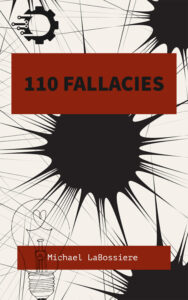 The question “why lie if the truth would suffice” can be interpreted in at least three ways. One is as an inquiry about the motivation and asks for an explanation. A second is as an inquiry about weighing the advantages and disadvantages of lying. The third way is as a rhetorical question that states, under the guise of inquiry, that one should not lie if the truth would suffice.
The question “why lie if the truth would suffice” can be interpreted in at least three ways. One is as an inquiry about the motivation and asks for an explanation. A second is as an inquiry about weighing the advantages and disadvantages of lying. The third way is as a rhetorical question that states, under the guise of inquiry, that one should not lie if the truth would suffice.
Since a general discussion of this question would be rather abstract, I will focus on a specific example and use it as the basis for the discussion. Readers should, of course, construct their own examples using their favorite lie from those they disagree with. I will use Trump’s response to the Democrats’ Green New Deal as my example. While this is something of a flashback to his first term, Trump recently signed an executive order targeting the old Green New Deal.
In 2019 the Democrats proposed a Green New Deal aimed at addressing climate change and economic issues. As with any proposal, rational criticisms can be raised against it. In his first term, Trump claimed the Democrats intend “to permanently eliminate all Planes, Cars, Cows, Oil, Gas & the Military – even if no other country would do the same.” While there are some Democrats who would do these things, the Democratic Party favors none of that. Looked at rationally, it seems to make no sense to lie about the Green New Deal. If it is bad enough to reject on its own defects, lies would not be needed. If one must lie to attack it, this suggests a lack of arguments against it. To use an analogy, if a prosecutor lies to convict a person, this suggests they have no case—otherwise they would rely on evidence. So, why would Trump lie if the truth would suffice to show the Green New Deal is a terrible plan?
The question of why Trump (or anyone else) lies when the truth would suffice is a matter for psychology, not philosophy. So, I will leave that question to others. This leaves me with the question about the advantages and disadvantages of lying along with the rhetorical question.
The lie about the Green New Deal is a good example of hyperbole and a straw man. Trump himself claims to use the tactic of “truthful hyperbole”. Hyperbole is a rhetorical device in which one makes use of extravagant overstatement, such as claiming that the Democrats plan to eliminate cows. The reason hyperbole is not just called lying is because it is a specific type of untruth and must have a foundation in truth. Hyperbole involves inflating or exaggerating something true rather than a complete fiction. The Green New Deal is aimed at making America carbon neutral and this would impact cars, cows, planes, oil, gas and the military. The extravagant exaggeration is that the proposal would eliminate all of them permanently. This would be as if someone proposed cutting back on dessert at family dinners and they were accused of wanting to eliminate meals permanently. Since hyperbole is rhetoric without logic, it has no logical force and does not prove (or disprove) anything. But it can have considerable psychological force in influencing people to believe a claim.
Hyperbole is often used in conjunction with the Straw Man fallacy. This fallacy is committed when a person’s actual position is ignored and a distorted, exaggerated or misrepresented version of that position is criticized in its place. This sort of “reasoning” has the following pattern:
Premise 1: Person A has position X.
Premise 2: Person B presents position Y (a distorted version of X).
Premise 3: Person B attacks position Y.
Conclusion: Therefore, X is false or bad.
This sort of “reasoning” is fallacious because attacking a distorted version of a position is not a criticism of the actual position. One might as well expect an attack on a poor drawing of a person to hurt the person.
Like hyperbole, the Straw Man fallacy is not based on a simple lie: it involves an exaggeration or distortion of something true. In the case of Trump and the Green New Deal, his “reasoning” is that the Green New Deal should be rejected because his hyperbolic straw man version of it is terrible. Since this is a fallacy, his “reasons” do not support his claim. It is, as always, important to note that Trump could be right about the Green New Deal being a bad idea, but not for the “reasons” he gives. To infer that a fallacy must have a false conclusion is itself a fallacy (the fallacy fallacy).
While hyperbole has no logical force and a straw man is a fallacy, there are advantages to using them. One advantage is that they are much easier than coming up with good reasons. Criticizing the Green New Deal for what it is requires knowing what it is and considering possible defects which take time and effort. Tweeting out a straw man takes seconds.
The second advantage is that hyperbole and straw men often work, often much better than the truth. In the case of complex matters, people rarely do their homework and do not know that a straw man is a straw man. I have interacted with people who honestly think Democrats plan to eliminate planes and cars. Since this is a bad idea, they reject it, not realizing that is not the Green New Deal. An obvious defense against hyperbole and straw man is to know the truth. While this can take time and effort, someone who has the time to post on Facebook or Twitter, has the time to do basic fact checking. If not, their ignorance should command them to remain silent, though they have the right to express their unsupported views.
As far as working better than the truth, hyperbole or straw man appeals to the target’s fears, anger or hope. They are thus motivated to believe in ways that truth cannot match. People generally find rational argumentation dull and unmoving, especially about complicated issues. If Trump honestly presented real problems with the Green New Deal, complete with supporting data and graphs, he would bore most and lose his audience. By using a straw man, he better achieves his goal. This does allow for a pragmatic argument for lying because the truth will not suffice.
If telling the truth would not suffice to convince people, then there is the pragmatic argument that if lying would do the job, then it should be used. For example, if going into an honest assessment of the Green New Deal would bore people and lying would get the job done, then Trump should lie if he wants to achieve his goal. This does, however, raise moral concerns.
If the reason the truth would not suffice is because it does not logically support the claim, then it would be immoral to lie. To use a non-political example, if you would not invest in my new fake company iScam if you knew it was a scam, getting you to invest in it by lying would be wrong. So, if the New Green Deal would not be refuted by the truth, Trump’s lies about it would be immoral.
But, what about cases in which the truth would logically support a claim, but the truth would not persuade people to accept that claim? Going back to the Green New Deal example, suppose it is terrible but explaining its defects would bore people and they would remain unpersuaded. But a straw man version of the Green New Deal would persuade many people to reject this hypothetically terrible plan? From a utilitarian standpoint, the lie could be morally justified; if the good of lying outweighed the harm, then it would be the right thing to do. To use an analogy, suppose you were trying to convince a friend to not start a dangerous diet. You have scientific data and good arguments, but you know your friend is bored by data and is largely immune to logic. So, telling them the truth would mean that they would go on the diet and harm themself. But, if you exaggerate the harm dramatically, your friend will abandon the diet. In such a case, the straw man argument would seem to be morally justified as you are using it to protect your friend.
While this might seem to justify the general use of hyperbole and the straw man, it only justifies their use when the truth does suffice logically but does not suffice in terms of persuasive power. That is, the fallacy is only justified as a persuasive device when there are non-fallacious arguments that would properly establish the same conclusion.

 Reasoning is like chainsaw: useful when used properly, but when used badly it can create a bloody mess. While this analogy can be applied broadly to logic, this essay focuses on the inductive generalization and how it can become a wayward chainsaw under the influence of fear. I’ll begin by looking at our good friend the inductive generalization.
Reasoning is like chainsaw: useful when used properly, but when used badly it can create a bloody mess. While this analogy can be applied broadly to logic, this essay focuses on the inductive generalization and how it can become a wayward chainsaw under the influence of fear. I’ll begin by looking at our good friend the inductive generalization.